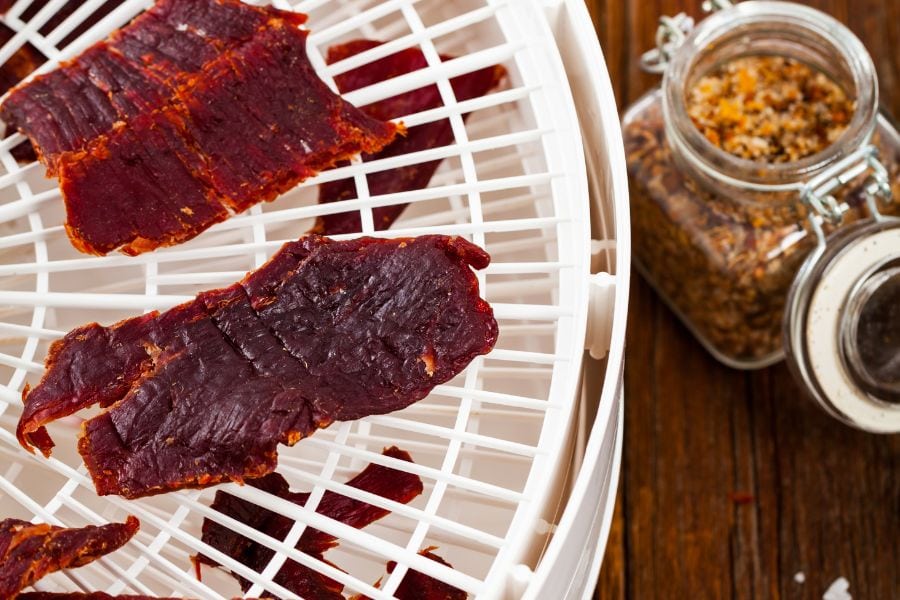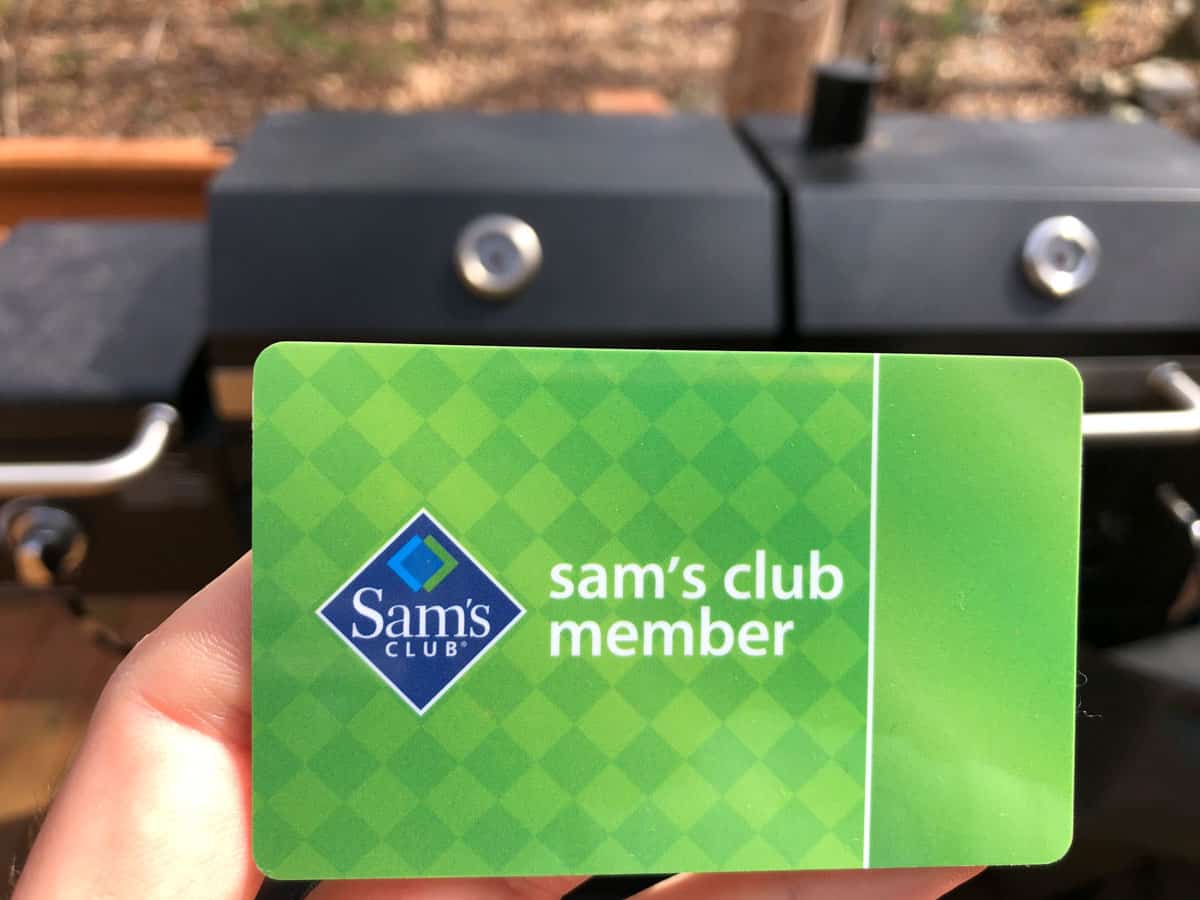Do you want to know how to make your own beef jerky? Look no further! This article will show you how to do it in a dehydrator, step by step. From picking out the meat to slice, marinating it with a great recipe, drying it out, and checking to see when it’s done, this includes everything.
Beef jerky is one of America’s favorite on-the-go snacks. This tasty, protein-packed meat can be found in purses, cars, lunch boxes, and backpacks across the country. But while store-bought jerky certainly gets the job done, making jerky at home lets you control the ingredients and customize the flavors to your taste.
The secret to making great homemade beef jerky is properly controlling the dehydration temperature and time. Dehydrating the meat correctly ensures the jerky reaches the perfect texture—not too dry and crumbly, not too soft and mushy. Most dehydrator manuals recommend settings around 145-170 degrees Fahrenheit. But within that range, 145 degrees yields the best results for chewy, tender jerky.
Here’s everything you need to know about dehydrating beef jerky at 145 degrees, including timing, troubleshooting, and tips for flavored jerky that’s healthy and delicious.
Why 145 Degrees for Beef Jerky?
Dehydrating meat at a low temperature—between 130 and 155 degrees F—allows the moisture to evaporate slowly for the best texture. Higher temperatures cause the exterior of the meat to harden before the inside has fully dried. The result is a jerky that’s tough and leathery on the outside but under-dried on the inside.
145 degrees hits the sweet spot right in the middle of the ideal low temperature dehydration range. At this setting moisture evaporates steadily over 4-10 hours ensuring even drying throughout each piece.
This slow dehydration also allows the meat’s enzymes to act on the proteins and tenderize the jerky. Temperatures above 160 degrees begin to deactivate these enzymes, leading to a tougher final product.
For safest results, the USDA recommends heating meat to 160 degrees F internally to eliminate harmful bacteria. A dehydrator set to 145 degrees won’t hit this milestone on its own. But starting at this lower temperature helps remove moisture and achieve better texture before finishing off with a high-heat step.
Dehydrating Time at 145 Degrees
The full dehydrating time depends on a few factors:
- Meat thickness – Thinner slices of jerky will dry faster.aim for 1/4 inch cuts.
- Fat content – Fattier meats retain more moisture. Trim off excess fat before dehydrating.
- Appliance wattage – More powerful dehydrators dry jerky faster
- Humidity – Dry climates dehydrate faster than humid ones.
In general, expect beef jerky to take 5-8 hours at 145 degrees in a dehydrator. Check for doneness at around 5 hours by bending a piece. Properly dried jerky will crack but not break when bent.
Ovens and convection ovens can also dehydrate jerky at 145 degrees, though air circulation is reduced compared to a dehydrator. This can extend the drying time to 6-10 hours. Rotate the racks and check frequently to account for uneven heating.
Step-by-Step Guide for Dehydrating Beef Jerky
Follow this simple process for perfectly dehydrated beef jerky every time:
- Prepare the meat – Trim off excess fat then slice with the grain into 1/4 inch strips.
- Marinate (optional) – Soak cuts in your favorite wet or dry jerky marinade 8-24 hours.
- Blot dry – Remove strips from marinade and pat off moisture with paper towels. Discard used marinade.
- Arrange in dehydrator – Lay pieces flat in a single layer, without overlapping or touching.
- Dehydrate at 145°F – Dry for 5-8 hours, checking periodically until jerky is slightly stiff but still flexible.
- Heat to 160°F – Increase dehydrator heat to 160°F and dry for at least 1 hour to eliminate bacteria.
- Cool and store – Let jerky cool completely then keep in an airtight container for up to 2 weeks.
Troubleshooting for Better Jerky Texture
Follow these tips if your homemade jerky turns out too hard, soft, or otherwise imperfect:
- Too dry and brittle – Dehydrate at slightly lower temp (135 – 140°F) and/or for less time.
- Under-dried and flexible – Increase dehydrating time in 1-hour increments until done.
- Hard exterior, moist interior – Use lower temp (135 – 140°F) from start to prevent case hardening.
- Curled strips – Cut precisely against the grain of meat; rotate racks during dehydrating.
- Fat pockets – Trim all visible fat before marinating and dehydrating.
- Bland flavor – Use a bold marinade; sprinkle with spices/seasonings before drying.
Flavorful Marinades and Spice Mixes for Jerky
One of the best parts about homemade jerky is choosing your own flavors. Consider these tasty marinade and spice ideas:
- Teriyaki – soy sauce, brown sugar, ginger, garlic, pepper flakes
- Bourbon – bourbon, brown sugar, Worcestershire sauce, black pepper
- Spicy Sriracha – Sriracha sauce, brown sugar, lime juice, garlic
- Tex-Mex – chili powder, cumin, garlic powder, oregano, cayenne
- Honey Maple Glaze – maple syrup, honey, smoked paprika, garlic powder
- Jamaican Jerk – allspice, thyme, habanero pepper, brown sugar
Make the Healthiest Jerky at Home
Beef jerky makes for a protein-rich snack, but unhealthy ingredients can sneak into store-bought brands or recipes. For the most nutritious jerky:
- Use lean meat, preferably grass-fed beef. Trim off any excess fat before dehydrating.
- Avoid jerky cured with nitrates/nitrites. Opt for natural preservatives like vinegar and salt instead.
- Skip high-sodium marinades. Limit soy sauce and add plenty of herbs and spices for flavor.
- Limit sugar in marinades. Moderate amounts of honey or maple syrup are OK.
- Use whole ingredients like garlic, pepper, paprika instead of powdered spices.
- Portion into 1 oz servings for a protein boost without overdoing calories or sodium.
Make a Batch for Road Trips, Hiking, and More
Homemade beef jerky is the ultimate convenience food to stash in your purse or glove box. It requires no refrigeration and provides a big punch of protein without the long ingredient labels.
Make up a few batches on your next day off to keep on hand for road trips, hiking, camping, or whenever hunger hits and convenience stores are the only option. Use an airtight container and your jerky will keep for up to 2 weeks at room temperature.
With the right timing and temperature, especially 145 degrees, you can easily achieve jerky that’s tender and chewy without being rubbery. Adjust the drying time as needed based on your preferred texture, thickness of cuts, and your dehydrator model. Then experiment with fun new flavors to make homemade jerky even better than the store-bought kind.

How to get the free membership?
Click here for the $45 gift card with sign up. (Jerkyholic is in no way associated with this deal. We do not get anything from Sams or you for you signing up; just passing along a great deal!)
It will give you a coupon code when filling out information. Write down that code and give it to the person at Sams’s membership desk. The woman we dealt with already had it, but just in case, write it down.
Where to buy meat – Free Sam’s Club Membership
Big box stores tend to have the best prices when it comes to meat for beef jerky. These include the main two, Sams Club and Costco. It’s great that you like to buy local. Butchers in your area usually charge more for their great cuts of meat. However, you are supporting local businesses.
Unfortunately, I do not have any good butchers locally and so I shop at Sams Club. There is a deal going on right now at Sams Club where you can join for $45 and get a $45 Sams Gift Card in the store the same day. So basically, the membership is free. We tested the offer on 3-16-21 and it works as advertised. Free Membership Valid until 4-30-2021.

When ls Jerky Done-Ronco Dehydrator
FAQ
Can I dehydrate jerky at 145?
Can you dehydrate beef jerky at 140 degrees?
How long to dehydrate jerky at 155 degrees?
How long do you need to dehydrate beef jerky?
Dehydrate the Jerky Dehydrate beef jerky in a dehydrator for anywhere between 3 and 6 hours. The drying time ranges due to several factors: ambient temperature and humidity, thickness of the meat, marbling of the meat, and the cut of meat to name a few.
How long does jerky take to dry?
Jerky should be dried for 3 hours at 165 degrees, allowing the internal temperature to reach 160 degrees. Then, turn down the temperature to 145F. Check the jerky after 4 hours and keep drying until it bends and cracks, but does not break in half. Allow jerky to cool for several hours before storing.
How do you dehydrate jerky?
Dehydration of Jerky Place the strips of meat in a single layer on drying racks after simmering or baking them to 160°F. Avoid overlapping or touching pieces. Dehydrate the strips at 140°F in a smoker, oven, or dehydrator. Maintain a constant dehydrator temperature of 140ºF during the process.
What temperature should beef jerky be dried at?
Since we mentioned such high temperatures as 160°F usually aren’t used to make beef jerky, drying it at 165°F is even rarer. It still is plausible, though, and as you’ve probably guessed, that way, the jerky will be done quickly! At 165°F, dehydrate the jerky for 2 hours.
